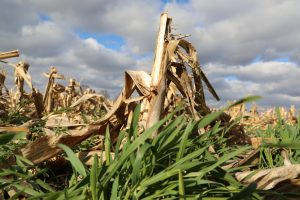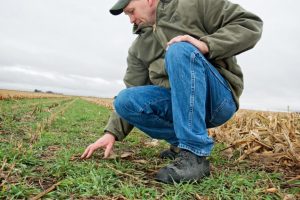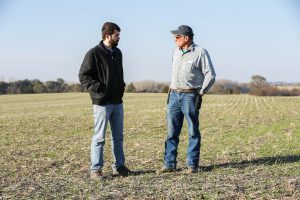Cover Crops: Various crops grown between the harvest of row crops (like corn or soybeans) and planting of the following year’s row crop to cover the soil, reduce nitrogen loss through plant uptake, and phosphorus loss through reduced erosion.
Resources
Short Article
Cover Crops — A Key to Reaching Nutrient Reduction Goals
Cover crops are an important component of the Iowa Nutrient Reduction Strategy (NRS). They provide significant and immediate benefits for water quality across all landscapes. Cover crops are planted in the late summer or fall, before or after harvest. They cover the soil during the winter and grow until the soil freezes. Winter hardy cover crops resume growth in the spring.
The Benefits
Cover crops can significantly reduce nitrate losses and soil erosion by taking up water and nitrate from the soil after the main crop is harvested in the fall and before the main crop starts to use significant amounts of water and nitrogen in the spring. Using cover crops are also beneficial for grazing livestock, improving soil fertility, suppressing weeds, and enhancing water quality.
With long-term use, cover crops can improve soil physical properties including water infiltration, increased soil organic matter, and increased water retention capacity.
(Insert farmer testimonial) Example:
(insert name) has been incorporating cover crops into his cropping system for (insert number of years). “We’ve seen some real changes in our soil health,” says (insert last name/location). “I feel the benefits are very sustainable and will carry forward for future years.”
What’s Next
Last year, Iowa farmers planted an estimated 760,000 acres of cover crops. “Intentional management of cover crops is necessary for success, but the soil health and water quality benefits are substantial” says (insert name of cropping expert from your company/organization) Contact (insert name/contact details) at (insert company/organization) for more information regarding incorporating cover crops into your cropping system and your conservation goals.
Longer article – technical
The use of cover crops is one of many practices being used across Iowa to reduce nutrients in water. Iowa’s water quality improvement strategy, the Iowa Nutrient Reduction Strategy (NRS), outlines several agricultural practices that can be effective, recognizing the variability that exists in the weather, geographical landscape, and soil types.
Cover crops are an important component of Iowa NRS because of significant and immediate benefits across many landscapes. Planted in the late summer or fall, cover crops help reduce the loss of nitrogen and phosphorous from the soil and capture nutrients for next year’s crop. Cover crops are flexible, improve our soil resource over time and require a relatively low capital investment.
The benefits? For crop farmers, the use of cover crops such as winter rye can reduce nitrogen loss by 31 percent and phosphorus loss by 29 percent on average. Other important benefits include reduced soil erosion, improved weed control, and improved soil health. With long-term use, most farmers observe soil health changes such as improved water infiltration, increased soil organic matter, increased water retention capacity, and improved resilience to more dramatic seasonal climate events.
Livestock producers incorporating cover crops benefit from reduced feed costs from this additional source of forage.
Are you ready? Last year, Iowa farmers planted an estimated 760,000 acres of cover crops across the state. One scenario of the Iowa NRS calls for an effort to increase this to 12 – 17 million acres statewide to have a significant, positive impact on water quality.
Many factors determine how effective cover crops will be at reducing nutrient loss. Improvement of water quality from cover crops depends on growth and establishment. To get the full benefits of cover crops, consideration should be given to the short growing season between crop harvest and cold winter weather, inconsistent rainfall, and the potential for decreased seed-to-soil contact if using aerial seeding applications. Cost also is a consideration since the expense is offset by benefits such as improved soil fertility and yields that may take three or more years to accrue. Other benefits may not be so easily monetized by row crop producers such as reduced soil erosion and nutrient loss.
Planning a cover crop program up to a year in advance of seeding is more likely to bring success. This planning includes identification of goals for the cover, such as reducing soil erosion, scavenging nutrients, providing livestock forage, or reducing compaction. Individual producer goals will impact cover crop species seed selection, seeding methods and many other management aspects. It is helpful during the planning phase to consult with farmers, agronomists, and others with cover cropping experience. The plan should also consider priority fields, cover crop species and variety, seeding method and timing, herbicide program, crop rotation, termination approach, and integration with manure application. Although having a good plan is essential, flexibility in adapting the plan to current conditions also is important.
Social Media Posts
#Covercrops can reduce erosion & improve soil quality and #waterquality. Last year, Iowa farmers planted an estimated 760,000 acres of cover crops.
#Covercrops reduce nitrogen loss by increasing nitrogen & water uptake outside the annual crop growing season.
We’re hosting a #Covercrop field day. Farmer-to-farmer learning is key with new practices to improve waterquality. Join us (add date and location details)!
#FarmersCoverIowa The practice of incorporating #covercrops into cropping systems is growing in Iowa and benefitting #waterquality. (NOTE: add field photo of cover crops during the growing season)
Facebook Post
Using cover crops can improve soil fertility, suppress weeds, help retain moisture, and enhance water quality as well as benefit grazing livestock. Visit the IAWA website to learn more: https://www.iowaagwateralliance.com/cover-crops/






